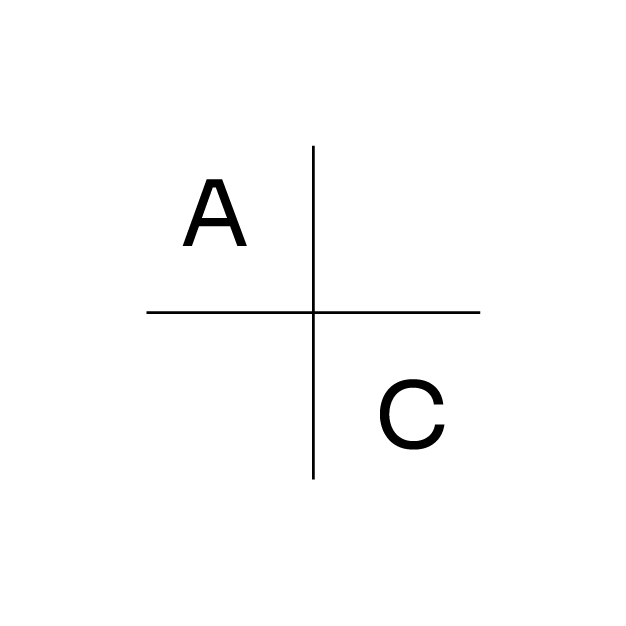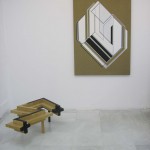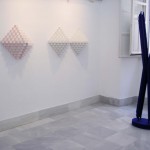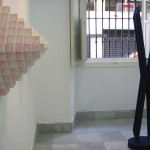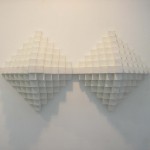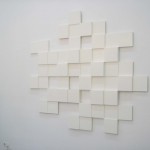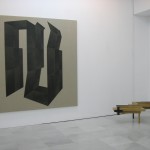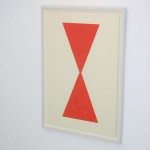Emilio Gañán. Pintura y Escultura
Pintura y Escultura. Emilio Gañán. 05.06.09_17.07.09
Rhythm, painting and time
Square canvases painted black. White and red lines generally move away from the symmetrical shafts of the squares, to form overlapping trapezoids. The obliqueness of the trapezoids and the eccentricity of the orthogonal create a strange expectation: the square appears to open out and in this way invites you to look in its interior. But there is nothing there, except painting.
These pieces from the series Arritmia, were the first that I saw by Emilio Gañán. At first glance you could understand them in two ways. On one hand, they refer to certain film outlines, black (like those that begin
and end in Centauros el Desierto) or white (in Cargo by the Cohen brothers), and open the transition from reality to fiction. In this sense, the works of Gañán seem to signal psychologically the illusion of art, the preliminary pleasure, that is to say, that which gives rise to the door of the museum or the mark of the picture frame (el parergon), by suggesting that we abandon the space regulated by the principle of reality.
In this way the squares are a metaphor for the promise of art which is only fulfilled through the material presence of painting.
Could it be understood, then, that the presence registered in the already vast succession of monochrome squares, the line that comes from Malevitch and Rodchenko, continues with Fontana and Yves Klein and arrives at Reinhardt and Robert Ryman?
There could be a more convincing explanation. It was evident when comparing the series Arritmia with a previous series called Puertas, which consisted of white rectangles with black lines and rectangular masses cut across with graffiti. These lines and surfaces create a particular space that not so much invites the gaze to track what is hidden or framed, but instead simply shows the architecture of the square, its structure. In contemplating the pieces in a museum or examining the pages of an art book, the different components of the painting (iconography, the layout of the figures, their relation with the
background, the appeal of colour, the softness of the light, etc) just leave room in the consciousness to suggest its general structure, the scale and the rhythmic changes. The reflection of Gañán centres itself in these notions, especially in the rhythm that gives the painting its main dynamic. He downplays many of the elements, creating the rhythmic scheme of the painting using language reduced to line, form, shadow and just one colour.
Geometric painting can be as seductive as any other and is limited, therefore, to offer mere ocular pleasure. It does not open a window in the wall but decorates it for rest or solace of the eyes.
This was not the claim of the avant-gardes, who in the first decades of the 20th century and especially after World War I, began to propose art which emphasized geometric properties in Russia, Germany, France and Holland.
This new movement in art has been related to the disaster and destruction caused by the so-called Great War. From a very different point of view, Kraus and Jünger note how in those years of brutal battle the technique had been put at the service of systematic destruction; Kraus also indicated the way in which technique and destruction had become united under an idea, the nation, which was enhanced by romantic rhetoric; a false enthusiasm that led to unprecedented destruction. From this situation it can be understood that certain artists held serious reservations about the primacy of expression in art and preferred to consider and construct work according to objective shapes and criteria, like for example the geometric, that abounds Espirit Nouveau, the magazine that was edited from 1920 by Ozenfant and Jeanneret (Le Corbusier).
However these reservations around immediate expression to a certain extent existed prior to the war disaster, which claimed for its own the development of science and technology. The abstraction of scientific languages demonstrated that the non-naturalistic culture which was appearing should somehow be incorporated into art.
The relation of art with technical language had arisen in Germany before the war under the influence of industrial design, but was developed following defeat with the works of Bauhaus which developed systematic research into the artistic possibilities of industrial materials, which until then had no artistic use, investigating geometric shapes and colour. Similar lines of work followed Russian constructivism that also theorized the relationship between the artist, engineer and worker.
It could be even be possible to add another central force to the formation of these artistic movements: the necessity to unite art with life. Not in abstract terms, but as concrete as it can be to dignify the daily life of the less fortunate social classes, whose contribution to the war was decisive. As a result they proposed new urban spaces, housing and furnishing in accordance with the way of industrial life, and a new artistic education.
Thus, the previous reservations surrounding immediate expression (sometimes uncontrolled, always easy to use by those who encourage base violence for the lure of dark ideals), the necessity of an art in accordance with science and capable of incorporating technical findings, and the possibility of that art opening more rational forms of life appeared to boost objective art of the 1920s. It did not search, then, for visual gratification, but pursued an artistic movement consistent with previously established languages. It did not reject emotion, but linked it to form. Ultimately culture begins when the word models cry and dance at the gesture, and the shapes relate with nature and each other.
It is easy to see that the painting of Emilio Gañán is descends from objective art (that continued into the Second World War in Latin America, France, Italy and Scandinavia, without forgetting the Spanish contribution of Equipo 57). This is why its geometry responds to a precise language and intention. A language created by the same box, square, grid, line and certain colours, and organized through a syntax that looks for certain tensions between these elements (the loss of symmetry and the contrast between the orthogonal and oblique), to indicate, in principal, a particular rhythm that suggests harmony, to comply with the limits of the box, to alter its interior.
However the intention of this language differs from that seen in the historical avant-gardes and even that which encouraged the movements of the second post-war period. Gañán, son of his time, references the work of Barnett Newman and Ellsworth Kelly, and understands that their painting reflects a period in which the image possesses a social function that was only seen in the inter-war years; a reflection that deepens and radicalizes with the first POP, and the expression of the New York School in the 1950s, and the diverse conceptual directions questioning the cultivation of form.
In the debate about the scope and possibilities of painting, the reflection of Gañán has a characteristically Spanish context. His pictures possess nothing more than formal echoes of the ideas of Pablo Palazuelo, but above all the early works of Yturralde and his interpretation of the paintings of Jordi Teixidor. Different paths in opposite directions, yet both opening interesting interpretations of the work of the young Extremaduran artist.
In the series Carbonos, Cristales y Aurum, Gañán establishes networks of lines that create figures that can be viewed both as three-dimensional objects, as well as flat polygonal shapes. He returns to a reflection on the structure of the traditional square, however in this case from the perspective of pictorial illusionism. In these pictures the planimetry coexists with the volumes, without the possibility of becoming fixed because the forms alter before the eyes of the spectator. In the final instance, the figures imposibles return to raise the problem of rhythm and on a second glance, offer the spectator a reflection on real and fictional space.
This reflection on perspective and space is characteristic of the conceptual and not psychological treatment of the figures imposibles by José María Yturralde. A similar approach is seen in the cited works of Gañán who presents these paradoxical pictorial forms, in flat rather than 3-dimensional form, in his series Floración. In it, white and orange flat vertical lines wave (if it is correct to use this term) with the presence of skewed lines that manage to convey a particular dynamism. It is true that they refer to the optical illusions of Ehrnstein, Zollner and Wundt, but-as occurs with the impossible figures of Yturralde in relation to those of Penrose- the intention of the works of Gañán is not psychological, but conceptual.
However in this inquiry into the scope and possibilities of painting, paradoxically Gañán does not disregard his love for painting. His squares do not present sharp, crystal surfaces in which the pigment is applied in such a way that it appears to lose its material condition, but in such a way that he demonstrates the quality of the strokes and the imprint of the hand of the painter. In these he depicts the gesture that applies the paint on the paper or canvas and the pulse that draws the lines. He underlines the dignity of the material when handling the pigment, which shows the process of painting. The picture thus retains the value of expression, although certainly contained (such as occurs in the works of Teixidor) by his submission to the project and the idea.
The ambivalence in the painting of Gañán can be expanded upon further, although in a different sense to that just proposed. The series Octubre, in my opinion, studies the relationship between the background and figure, and the overlapping planes in simple forms, can be seen on occasion similar to those employed in traditional painting employed to model forms with light, the series Cristales uses brightness and transparency to emphasize impossible scales. Take the allusions to traditional painting in citas. They are not exempt of irony, but not free from nostalgia. Ultimately Gañán´s inquiry alludes to the warm memory of the great painting.
This memory returns us to the final, perhaps most personal aspect of the work of Gañán. I refer to tiempo. The rhythms that arise from the alteration of harmony in his first works are evidence of a preoccupation with time that is transferred to the viewer such as in tiempo de su percepción, because the pictures are not resolved in an instant look but either move one to contemplation, rather to a certain reflection that encourages the viewer to wonder what he is seeing, and immediately, why it appears like this. Apart from these works, time has a charged presence in two recent series, Filos de cima and Fusión Lenta. The succession of structures in the first series and the conjunction of forms throughout the six works that compose the second are not limited to open spaces or geometric transformations, but rather pose a cadence that forces successive views and is at the same time restful. It is a painting that makes present the duration.
This valuation of time, of the duration, is perhaps the point which unites the two elements, at first view contrasting, in the work of Gañán: the accurate reflection generated by his work and the taste for the materiality of painting and the uncertainty of the gesture. Time is our condition. He makes us distrust that which is presumed to be permanent, and returns us to think of the beginnings and to demonstrate the artifice of its condition artifice. But this critical thinking is also given in time and memory which saves como pintura. It may be that time is the element that unifies Gañán´s poetics.
VI
Emilio Gañán is a young painter. He has begun, however an ambitious path in which, for the moment, he will establish necessary and difficult milestones for the artist, to form their own world which must at once be authentically individual and capable of interacting with others. A world that has been constructed through decisions- always played through the pain of what is abandoned – and through attention to the various languages that develop in our culture (that cannot be disregarded on behalf of puritans that usually hide the features of Narcissus). It is a laborious task which is however key to a poetics that are really your own. I have intended to expose some of the aspects of his poetics. It is time, which so interests this author, which will be decisive in assessing his development.
Juan Bosco Díaz-Urmeneta
